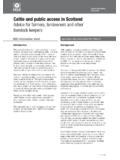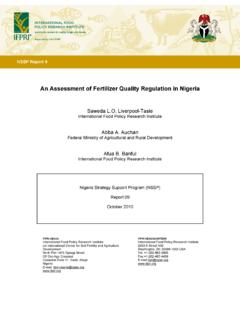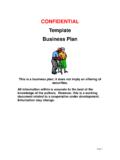Transcription of Cattle and public access in England and Wales: …
1 1 of 3 pagesHealth and Safety ExecutiveHealth and Safety ExecutiveAgriculture Information Sheet No 17EW(rev1) HSE information sheetCattle and public access in England and Wales Advice for farmers , landowners and other livestock keepersIntroduction This sheet describes the major hazards to members of the public associated with keeping Cattle , including bulls (uncastrated bovine animals of 10 months or over) and newly calved cows, in fields where the public have access in England and Wales. It suggests reasonably practicable ways of controlling those hazards for walkers. Land managers should also consider risks to other rights of way users such as horse riders and cyclists. It does not provide advice on housing bulls or other Cattle , nor on safe is a considerable network of public rights of way in the UK which are regularly used by walkers and others, often accompanied by dog(s).
2 In addition the Countryside and Rights of Way Act 2000 (CROW) gave the public the right to walk on mapped access land which includes mountain, moor, heath, down and registered common land. Open access or access along specified routes is also permitted on other land, some of it in public ownership. This land may also be crossed by public rights of way. Throughout this information sheet, fields with public access means fields or enclosures where the public have a statutory right of access or have been given permission by the landowner. It does not include fields which the public access without permission, or without a statutory right. Specific information on the responsibilities of the public exercising their right of access can be found in Further reading . Background HSE regularly investigates incidents involving Cattle and members of the public in England and Wales.
3 Some of these result in death or serious injuries. Almost all of these incidents are in fields and enclosed areas. Many other incidents occur but are not reported to or investigated by HSE. The two most common factors in these incidents are cows with calves and walkers with dogs. All large animals are potentially dangerous. You should try to ensure that the Cattle you own or breed from are of a normally quiet temperament. However, when under stress (eg because of the weather, illness, unusual disturbance, or when maternal instincts are aroused), even normally placid Cattle can become aggressive. Even gentle knocks from Cattle can result in people being injured. All breeds should be treated with respect. Members of the public , including walkers and children, may not understand that Cattle with calves at foot can present a risk due to protective maternal instincts, especially when a dog is present.
4 When you are considering where to keep livestock you should take into account that members of the public are unlikely to be aware of the behavioural characteristics of Cattle . You should also consider the amount and type of public access in different areas of the land you manage (eg large groups of walkers with dogs every day, groups of children, or infrequent lone walkers). This will help you decide whether the Cattle should be kept in certain areas and what precautions you need to take. Precautions if you graze bulls or groups of entire male Cattle for bull beefBulls of recognised dairy breeds (eg Ayrshire, Friesian, Holstein, Dairy Shorthorn, Guernsey, Jersey and Kerry) are in all circumstances banned from being at large in fields crossed by public rights of way. Do not keep them in fields with public rights of way, statutory or other types of permitted you are considering putting a bull of any other breed in a field to which the public have access you should carefully consider the animal s temperament and behaviour and monitor its demeanour and state of health on a frequent basis.
5 If there is any indication that the bull is likely to be aggressive or unpredictable, or if or if its behaviour gives you cause for concern, it should not be kept in a field to which the public have the right of bulls are banned from fields or enclosures 2 of 3 pagesHealth and Safety Executivewith footpaths unless accompanied by cows or heifers. This does not include open fells or unenclosed moorland. There are no specific prohibitions on other Cattle . In other fields make sure that groups of animals older than 10 months are securely enclosed by stock-proof hedging or fencing at least m high, strong enough to retain the animals and capable of restricting access of children. Erecting an electric fence m inside the external perimeter hedge or fence will provide a greater degree of security. Fit gates or other means of closure at points of entry into the fields containing the Cattle .
6 Gates etc should be at least of equal height and strength as the perimeter fencing, should restrict the access of young children and be fitted with a securing device which will prevent release by children and/or the animals. They can also be kept locked as they will not be sited on public rights of way. Precautions if you graze other cattleBefore you put any Cattle , including bulls, in fields with public access : assess whether the bull or animals in the herd are generally placid and well-behaved; if possible use fields or areas not used by the public when Cattle are calving or have calves at foot, especially during periods of greater public use, eg school holidays; assess whether calves kept with the herd will affect the behaviour of older Cattle ; consider whether it is reasonably practicable to temporarily fence alongside a public right of way so that the Cattle and people are kept separate.
7 Take care not to obstruct rights of way by fencing across them; an alternative route can be offered or provided, but bear in mind that even if you do decide to provide an alternative route, the public will still be entitled to use the right of way; plan the location of handling and feeding areas away from public rights of way to reduce the possibility of stock congregating around the route; where the landowner and the Cattle owner are not the same person there may be some joint responsibility and it is the duty of both parties to agree a course of action; on land to which CROW applies, it may be possible under some circumstances to restrict access to avoid danger to the public , although public rights of way still remain usable (see Further information ); consider providing signposted paths, especially on CROW land, to draw most public access along routes which are best integrated with livestock management.
8 If you have an animal known or suspected to be aggressive then you should not keep it in a field that is used by the to minimise the risk to the public Wherever possible keep Cattle in fields that do not have public access , especially when Cattle are calving or have calves at foot. Check that fences, gates, stiles etc are safe and fit for their purpose. Check paths are clearly marked so that users do not enter fields without public access . Make arrangements for checking both the Cattle (for illness or other possible causes of aggression) and the fences etc surrounding the field regularly at least once each day. Plan how to safely move individual Cattle , the whole herd, or part of it, from field to field. Remember that inadequately controlled Cattle on roads can cause public concern, damage or injury. Ensure Cattle handling facilities are available, and that you can safely move animals to them.
9 If bulls are on hire, lease, or loan, or if other Cattle are new to the farm, check that they are suitable to keep in an area used by the public before putting them in such an area. A few days in another field or in a stock building, where they can be closely and regularly observed, should be enough. Signs Even though you should have made every effort not to keep aggressive, or potentially aggressive, animals in a field or area with public access , it is good practice to display signs informing the public when a bull, or calves with cows, are in the area. Consider putting a sign at any gate, stile or other access points to a field or open area such as fell, hill or moorland if there is a bull, or cows with calves, at large there. Signs should conform with suitable standards (see Further reading).A suitable bull sign would be triangular with a yellow background and a black band around the outside.
10 A bull or bull s head should be shown (black on yellow) on the sign, with supplementary text (also black on yellow) such as bull in field if desired. Supplementary text should not suggest that the bull is aggressive, threatening or dangerous (ie avoid words such as beware or danger ). Signs alerting the public to the presence of other Cattle , including cows with calves, should be informative and based on guidance from Natural Health and Safety Executive3 of 3 pagesPublished by the Health and Safety Executive AIS17EW(rev1) 08/12 England or the Countryside Council for Wales. The use of symbols will help children, and those unable to read, to be aware of the risks. Signs should not be displayed, or should be securely covered, when the animals to which they refer are not present in the field or area. Misleading signs which deter the public from exercising their right of responsible access are likely to be regarded as obstruction and should never be used.
















